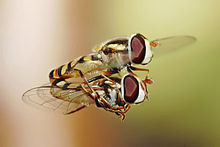- Global biodiversity
-
The biodiversity of planet Earth is the total variability of life forms forms. Currently about 1.9 million species are known, but this is thought to be a significant underestimate of the total number of species.
Biodiversity has grown and shrunk in earth's past due to changes abiotic factors such as mass extinction, change in oxygen levels and sea levels. Climate change 300 million years ago was one such event. A cooling and drying resulted in catastrophic rainforest collapse and subsequently a great loss of diversity, especially of amphibians.[1]
Current threats to global biodiversity include natural extinction, an event that occurs to species yearly, as well as human actions such as pollution. Invasion of non-native species can also have a negative affect on global biodiversity.
Contents
Measuring Diversity
Biodiversity is usually plotted as the richness of a geographic area, with some reference to a temporal scale. Types of biodiversity include:
- taxonomic diversity
- species diversity
- ecological diversity
- morphological diversity
- genetic diversity
Taxonomic diversity, that is the number of species, genera, family is the most commonly assessed diversity type.[2] A few studies have attempted to quantitatively clarify the relationship between different types of diversity. For example, Sarda Sahney a researcher at the University of Bristol has found a close link between vertebrate taxonomic and ecological diversity.[3]
Known species
The numbers of identified modern species as of 2010 can be broken down as follows:[4]
- 3,067 brown algae
- 321,212 plants, including:
- 10,134 red & green algae
- 16,236 mosses,
- 12,000 ferns & horsetails,
- 1,021 gymnosperms,
- 281,821 angiosperms;
- 74,000-120,000 fungi;[5]
- 17,000 lichens;
- 1,367,555 animals, including:
- 1,305,250 invertebrates
- 2,175 corals
- 85,000 mollusks
- 102,248 arachnids
- 47,000 crustaceans
- 1,000,000 insects
- 62,305 vertebrates
- 31,300 fish,
- 6,433 amphibians,
- 9,084 reptiles,
- 9,998 birds,
- 5,490 mammals.
- 68,827 other animal species;
- 1,305,250 invertebrates
Estimates of total number of species
However the total number of species for some taxa may be much higher.
One early estimate by Terry Erwin put global species richness at 30 million, following extrapolations from the numbers of beetles found in a species of tropical tree. In one species of tree, Erwin identified 1200 species of beetle, of which he estimated 163 were found only in that tree[citation needed]. Based on the 50,000 species of tropical tree, this would suggest that there are almost 10 million species of beetle in the tropics.
It is interesting to mention that according to the school of Indian philosophy known as(Vedanta) there are 8.4 million types of living beings on earth.[9] This statement was made more than 1000 years ago.
See also
2010 Biodiversity Indicators Partnership
References
- ^ Sahney, S., Benton, M.J. & Falcon-Lang, H.J. (2010). "Rainforest collapse triggered Pennsylvanian tetrapod diversification in Euramerica" (PDF). Geology 38 (12): 1079–1082. doi:10.1130/G31182.1. http://geology.geoscienceworld.org/cgi/content/abstract/38/12/1079.
- ^ Sahney, S. and Benton, M.J. (2008). "Recovery from the most profound mass extinction of all time" (PDF). Proceedings of the Royal Society: Biological 275 (1636): 759–65. doi:10.1098/rspb.2007.1370. PMC 2596898. PMID 18198148. http://journals.royalsociety.org/content/qq5un1810k7605h5/fulltext.pdf.
- ^ Sahney, S., Benton, M.J. and Ferry, P.A. (2010). "Links between global taxonomic diversity, ecological diversity and the expansion of vertebrates on land" (PDF). Biology Letters 6 (4): 544–547. doi:10.1098/rsbl.2009.1024. PMC 2936204. PMID 20106856. http://rsbl.royalsocietypublishing.org/content/6/4/544.full.pdf+html.
- ^ Current Results– Number of Species on Earth
- ^ a b David L. Hawksworth, "The magnitude of fungal diversity: the 1•5 million species estimate revisited" Mycological Research (2001), 105: 1422-1432 Cambridge University Press [1]
- ^ Encyclopedia Smithsonian: Numbers of Insects
- ^ Proceedings of the National Academy of Sciences, Census of Marine Life (CoML) [2]
- ^ Acari at University of Michigan Museum of Zoology Web Page
- ^ Paramhans Swami Maheshwarananda , The hidden power in humans, Ibera Verlag, page 17., ISBN 3-85052-197-4
External links
Categories:
Wikimedia Foundation. 2010.


